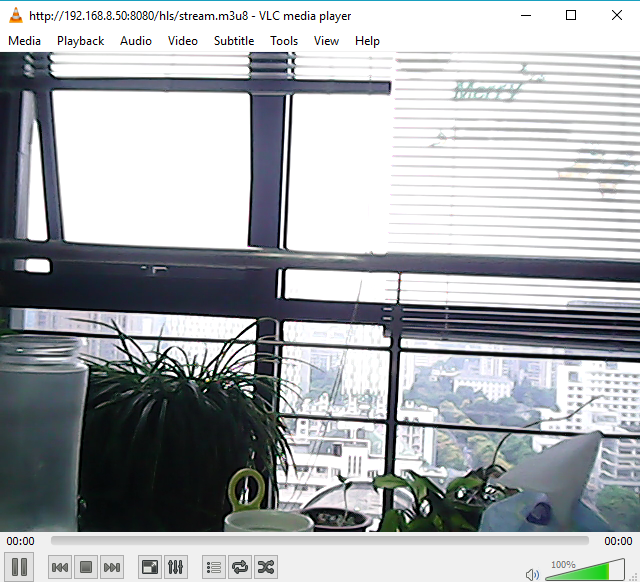Raspberry Pi Live Streaming with USB Webcam
For the past week, I was looking for a live streaming solution to broadcast video from a USB webcam that connects to Raspberry Pi. This post will help you set up a live streaming server on Raspberry Pi step by step.
Installing FFmpeg on Raspberry Pi
My first try was to type in **sudo apt-get install ffmpeg** on the command line. Then I got the error message: Package `ffmpeg’ has no installation candidate.
Fornatutely, we can get the source code of FFmpeg from GitHub and build it ourselves referring to the article – FFMPEG for Raspberry Pi.
Before building FFmpeg, you have to build dependent codec libraries. Assume you want to stream video in Ogg format, you need the video codec libtheora, which depends on libogg-1.3.1 and libvorbis-1.3.3.
Run the following commands to build and install FFmpeg:
wget http://downloads.xiph.org/releases/vorbis/libvorbis-1.3.3.tar.gz
tar -xf libvorbis-1.3.3.tar.gz
cd libvorbis-1.3.3/
./configure --host=arm-unknown-linux-gnueabi --enable-static
make
sudo make install
wget http://downloads.xiph.org/releases/ogg/libogg-1.3.1.tar.gz
tar -xf libogg-1.3.1.tar.gz
cd libogg-1.3.1/
./configure --host=arm-unknown-linux-gnueabi --enable-static
make
sudo make install
wget http://downloads.xiph.org/releases/theora/libtheora-1.1.1.tar.bz2
tar -xf libtheora-1.1.1.tar.bz2
cd libtheora-1.1.1/
./configure --host=arm-unknown-linux-gnueabi --enable-static
make
sudo make install
git clone git://git.videolan.org/x264
cd x264
./configure --host=arm-unknown-linux-gnueabi --enable-static --disable-opencl
make
sudo make install
git clone https://github.com/FFmpeg/FFmpeg.git
cd ffmpeg
sudo ./configure --arch=armel --target-os=linux --enable-gpl --enable-libx264 --enable-nonfree --enable-libtheora --enable-libvorbis
make
sudo make install
Live Streaming with FFServer
Once FFmpeg installed, you can run ffserver. By default, ffserver loads a configuration file /etc/ffserver.conf. On Raspberry Pi, you need to create it manually. Please refer to ffserver sample page. Here is my configuration for Ogg format:
HTTPPort 9090
HTTPBindAddress 0.0.0.0
MaxHTTPConnections 2000
MaxClients 1000
MaxBandwidth 100000
#NoDaemon
<Feed feed1.ffm>
File /tmp/feed1.ffm
FileMaxSize 200K
ACL allow 127.0.0.1
</Feed>
<Stream test.ogg>
Format ogg
Feed feed1.ffm
VideoCodec libtheora
VideoFrameRate 24
VideoBitRate 512
VideoSize 320x240
VideoQMin 1
VideoQMax 31
VideoGopSize 12
PreRoll 0
AVOptionVideo flags +global_header
Noaudio
</Stream>
<Stream stat.html>
Format status
# Only allow local people to get the status
ACL allow localhost
ACL allow 192.168.0.0 192.168.255.255
</Stream>
Run ffserver and send the video stream:
ffserver -f /etc/ffserver.conf & ffmpeg -re -f video4linux2 -i /dev/video0 -vcodec libtheora http://localhost:9090/feed1.ffm
How to stop ffserver? I got the solution from StackOverflow. Find the port and kill the process:
netstat -tulnap
sudo fuser -k 9090/tcp
Use ffplay or vlc to play the stream:
ffplay http://192.168.8.50:9090/test.ogg
Live Streaming with Nginx RTMP Module
Inspired by the post https://docs.peer5.com/guides/setting-up-hls-live-streaming-server-using-nginx/, I have made Nginx work as a live streaming server on Raspberry Pi.
Get the source code of nginx-rtmp-module:
git clone https://github.com/sergey-dryabzhinsky/nginx-rtmp-module.git
Install Nginx dependencies:
sudo apt-get install build-essential libpcre3 libpcre3-dev libssl-dev
Install Nginx:
wget http://nginx.org/download/nginx-1.12.1.tar.gz
tar -xf nginx-1.12.1.tar.gz
cd nginx-1.12.1
./configure --with-http_ssl_module --add-module=../nginx-rtmp-module
make -j 2
sudo make install
Create a folder hls under /usr/local/nginx/html:
sudo mkdir /usr/local/nginx/html/hls
Edit /usr/local/nginx/conf/nginx.conf:
rtmp {
server {
listen 1935; # Listen on standard RTMP port
chunk_size 4000;
application show {
live on;
# Turn on HLS
hls on;
hls_path /usr/local/nginx/html/hls/;
hls_fragment 3;
hls_playlist_length 60;
# disable consuming the stream from nginx as rtmp
deny play all;
}
}
}
http {
server {
listen 8080;
location /hls {
# Disable cache
add_header 'Cache-Control' 'no-cache';
# CORS setup
add_header 'Access-Control-Allow-Origin' '*' always;
add_header 'Access-Control-Expose-Headers' 'Content-Length';
# allow CORS preflight requests
if ($request_method = 'OPTIONS') {
add_header 'Access-Control-Allow-Origin' '*';
add_header 'Access-Control-Max-Age' 1728000;
add_header 'Content-Type' 'text/plain charset=UTF-8';
add_header 'Content-Length' 0;
return 204;
}
types {
application/dash+xml mpd;
application/vnd.apple.mpegurl m3u8;
video/mp2t ts;
}
root html;
}
}
}
Start Nginx:
sudo /usr/local/nginx/sbin/nginx
Reload Nginx:
sudo /usr/local/nginx/sbin/nginx -s reload
Send video stream:
ffmpeg -re -f video4linux2 -i /dev/video0 -vcodec libx264 -acodec aac -strict -2 -f flv rtmp://192.168.8.50/show/stream
Send video stream from Windows:
ffmpeg -re -f dshow -rtbufsize 100M -i video="USB2.0 Camera" -vcodec libx264 -acodec aac -strict -2 -f flv rtmp://192.168.8.50/show/stream
Play the stream:
vlc http://192.168.8.50:8080/hls/stream.m3u8
ffplay http://192.168.8.50:8080/hls/stream.m3u8



